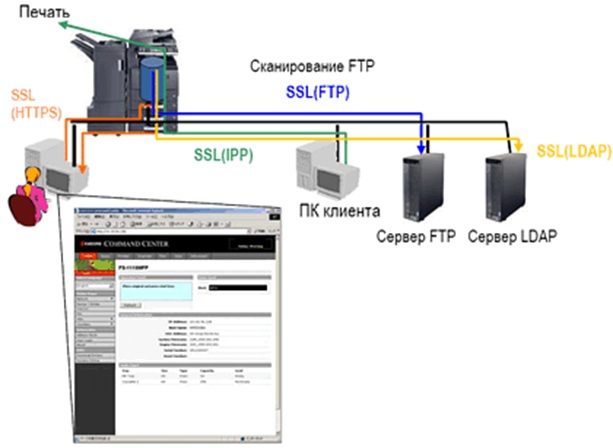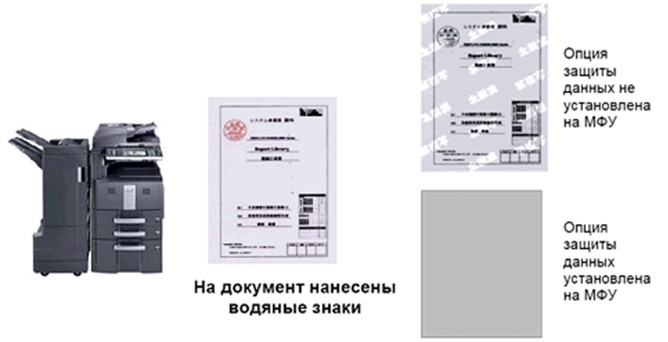KYOCERA SECURITY SOLUTIONS
Let's be honest, security is a critical issue in offices. A huge number of people use the same device together, including for working with documents of a confidential nature. Here we will talk about the solutions that are used in KYOCERA devices for security.
IPsec Technologies The
new single-processor controller used in some of the new full-color MFPs provides enhanced protection for the data and the MFP itself through the use of SSL, IPv6 and IPsec. These features provide users with increased operational efficiency in a secure local area network.
Recall what IPsec is. This is a technology that implements the protection function of the IP protocol, which is a basic element of the Internet infrastructure. Due to the appropriate use of IPsec technology in new MFPs, it is possible to avoid the impact on MFPs of attacks aimed at violating data integrity or theft.
Using SSL
To protect information from unauthorized access in the new series of MFPs, encryption of data transmitted over the local network is supported, as well as access protection to information located in the MFP. Using the SSL protocol allows you to protect information when:
• Printing data from the client PC to the MFP
• Scanning from the MFP via FTP
• Transferring data between the MFP and the LDAP server
• Transferring data between the MFP and the KYOCERA COMMAND CENTER using the HTTP (Web) protocol.

Thus, when using new MFPs, you can protect not only the printed data, but also the data obtained by scanning.
Authentication in a network environment
For cases when the MFP is used as a public device of a large workgroup, the new series of devices support the authentication function, which uses a username and password to organize access to the MFP and data. In this case, both local authentication and network authentication can be used.
With local authentication, user names and passwords are stored on the MFP itself. This method is recommended to be used when using the MFP series as a stand-alone device, as well as in small enterprises with peer-to-peer networks without dedicated servers.

Network Authentication supports Active Directory servers running the Windows operating system. It is preferable to use it in conditions of large local networks of large enterprises with dedicated servers in their structure.

Thus, in the case of using the network authentication function, the user does not need to remember several passwords and user names (one for working on his PC, and the other for using the MFP), since the same password and username will be used to access the MFP, which The user uses to access his PC.
Using data encryption technology
When copying, printing, scanning and sending messages through a fax line, a certain data array is formed on the MFP hard disk, which is stored there until it is overwritten by other data during the next operation of copying, printing, scanning and sending a fax message . This is true for any MFP of any manufacturer. Until the data array has been overwritten, there is a theoretical possibility of accessing this data block from the outside in order to steal information
In order to prevent possible data leakage on the new series MFPs, the option of overwriting / encrypting the data located on the MFP's hard disk can be installed. This option automatically overwrites data on the MFP hard drive after completing each task, as well as encrypts the data while it is being written to the MFP hard drive. In this case, decoding of encrypted data cannot be performed by other devices, which eliminates the risk of data leakage. It should be noted that in addition to the data, the MFP address book is encrypted in the same way.
Ability to protect documents from unauthorized printing / transmission / scanning
If necessary, the option to protect printed documents from unauthorized copying, transmission or scanning can be installed on new full-color MFPs. This option allows you to protect the information of printed documents from unauthorized copying, scanning or sending via fax lines using special watermarks. If you try to unauthorized copy, scan or send a protected document through fax lines on the same MFP of the series, the image of the first page of the copy will be hidden by a solid background, and scanning and sending the document through fax lines will be unavailable.

If you try to unauthorized copy a protected document on any other digital photocopier or MFP, the corresponding messages will be displayed on the resulting copies as a background image.
This data protection function is only available when using PCL XL.
IPsec Technologies The
new single-processor controller used in some of the new full-color MFPs provides enhanced protection for the data and the MFP itself through the use of SSL, IPv6 and IPsec. These features provide users with increased operational efficiency in a secure local area network.
Recall what IPsec is. This is a technology that implements the protection function of the IP protocol, which is a basic element of the Internet infrastructure. Due to the appropriate use of IPsec technology in new MFPs, it is possible to avoid the impact on MFPs of attacks aimed at violating data integrity or theft.
Using SSL
To protect information from unauthorized access in the new series of MFPs, encryption of data transmitted over the local network is supported, as well as access protection to information located in the MFP. Using the SSL protocol allows you to protect information when:
• Printing data from the client PC to the MFP
• Scanning from the MFP via FTP
• Transferring data between the MFP and the LDAP server
• Transferring data between the MFP and the KYOCERA COMMAND CENTER using the HTTP (Web) protocol.

Thus, when using new MFPs, you can protect not only the printed data, but also the data obtained by scanning.
Authentication in a network environment
For cases when the MFP is used as a public device of a large workgroup, the new series of devices support the authentication function, which uses a username and password to organize access to the MFP and data. In this case, both local authentication and network authentication can be used.
With local authentication, user names and passwords are stored on the MFP itself. This method is recommended to be used when using the MFP series as a stand-alone device, as well as in small enterprises with peer-to-peer networks without dedicated servers.

Network Authentication supports Active Directory servers running the Windows operating system. It is preferable to use it in conditions of large local networks of large enterprises with dedicated servers in their structure.

Thus, in the case of using the network authentication function, the user does not need to remember several passwords and user names (one for working on his PC, and the other for using the MFP), since the same password and username will be used to access the MFP, which The user uses to access his PC.
Using data encryption technology
When copying, printing, scanning and sending messages through a fax line, a certain data array is formed on the MFP hard disk, which is stored there until it is overwritten by other data during the next operation of copying, printing, scanning and sending a fax message . This is true for any MFP of any manufacturer. Until the data array has been overwritten, there is a theoretical possibility of accessing this data block from the outside in order to steal information
In order to prevent possible data leakage on the new series MFPs, the option of overwriting / encrypting the data located on the MFP's hard disk can be installed. This option automatically overwrites data on the MFP hard drive after completing each task, as well as encrypts the data while it is being written to the MFP hard drive. In this case, decoding of encrypted data cannot be performed by other devices, which eliminates the risk of data leakage. It should be noted that in addition to the data, the MFP address book is encrypted in the same way.
Ability to protect documents from unauthorized printing / transmission / scanning
If necessary, the option to protect printed documents from unauthorized copying, transmission or scanning can be installed on new full-color MFPs. This option allows you to protect the information of printed documents from unauthorized copying, scanning or sending via fax lines using special watermarks. If you try to unauthorized copy, scan or send a protected document through fax lines on the same MFP of the series, the image of the first page of the copy will be hidden by a solid background, and scanning and sending the document through fax lines will be unavailable.

If you try to unauthorized copy a protected document on any other digital photocopier or MFP, the corresponding messages will be displayed on the resulting copies as a background image.
This data protection function is only available when using PCL XL.
